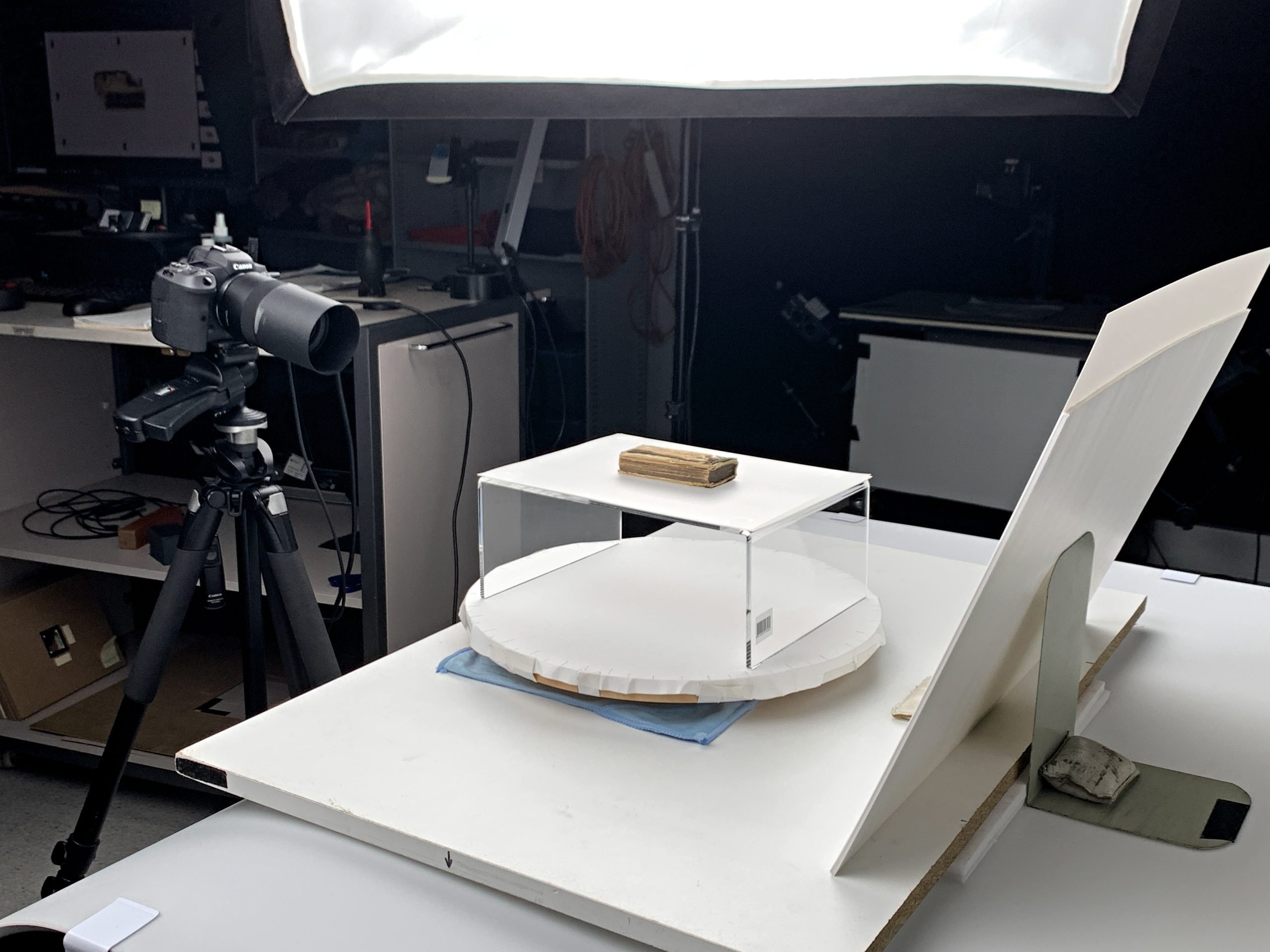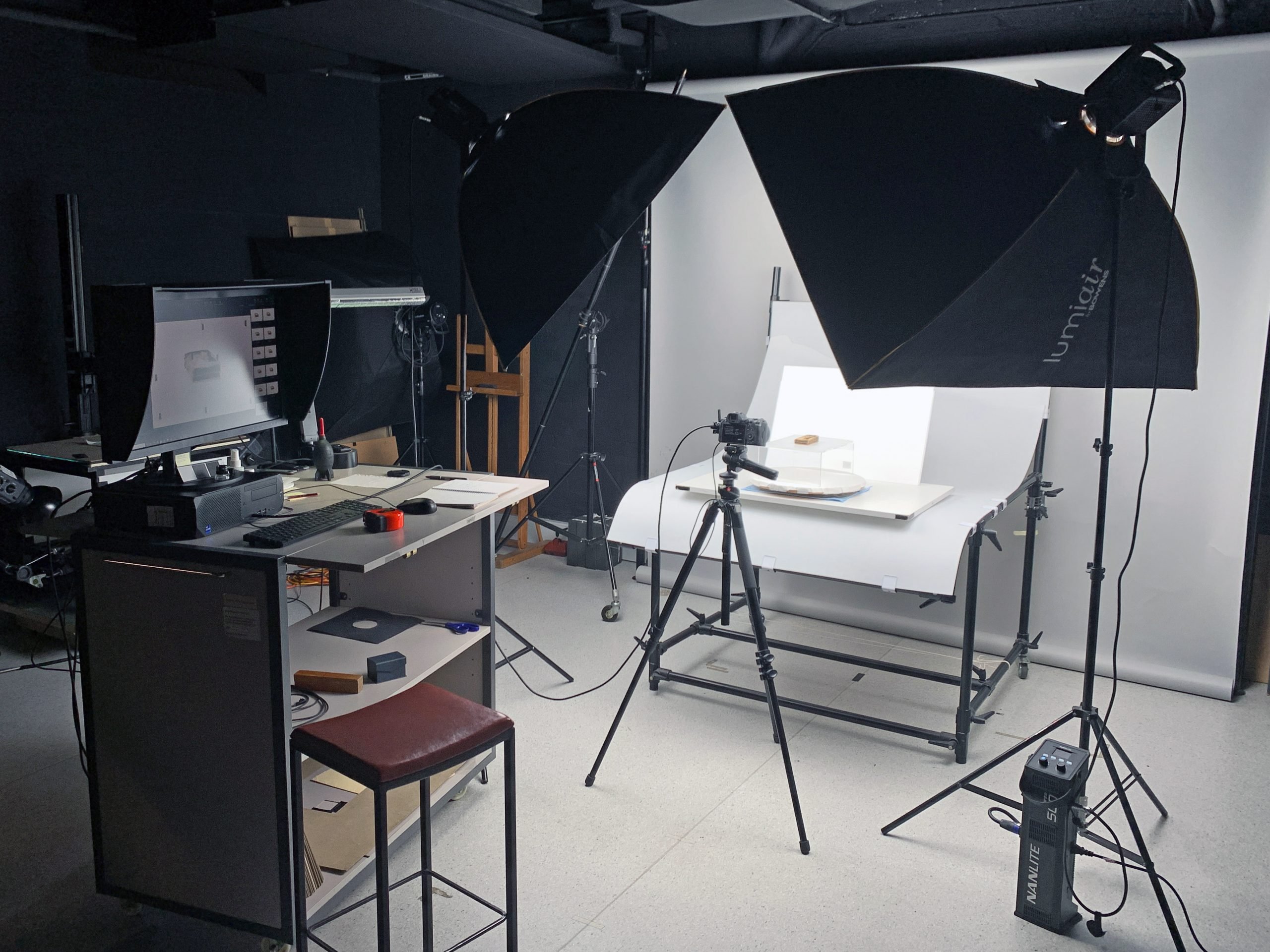In May 2021 Dr Katrina Grant, Senior Lecturer, Digital Humanities and Professor Mitchell Whitelaw, Associate Professor, Design, School of Art from the Australian National University visited the Library’s Digital Production (DP) team in their Imaging studio. Their purpose was to provide a demonstration and introduce the DP team to the concept of crafting 3D digital assets through a technique known as photogrammetry.
At that time, the DP team had been assigned the task of generating seven 3D digital assets for an upcoming digital exhibition named Beyond the Book: A digital journey through the treasures of the Emmerson Collection. This exhibition was set to be launched in August 2023. The demo marked the team’s initial exposure to the creation of 3D assets.
Subsequently, the team faced the challenges of a COVID-induced lockdown. During this period, Anne-Marie De Boni, Digital Production Manager, familiarised herself with the photogrammetry software Metashape. Her aim was to grasp the fundamentals and identify equipment requirements needed for the Library to complete the project. This included procuring continuous LED lighting, a high-performance computer with a robust graphics card, the photogrammetry software Agisoft Metashape, a mirrorless camera and a high-quality prime lens.
The DP team gained a new member, Bart Geraedts, a Senior Production Technician, in September 2021. This addition marked a turning point as the team recommenced their on-site activities.
Upon their return, DP met with Katrina Ben, Senior Conservator, Books in the Library’s Conservation lab to inspect seven rare books that had been identified to create 3D models of. They were not only delicate, but some featured intricate metallic embroidery. Katrina was on hand throughout the photographic capture process to handle and care for these fragile and valuable items. In addition, to minimise exposure of these items from intense photographic lighting, the decision was made to employ a dummy model during the testing phase.
Alongside discussions with Peter Mappin, Digital Production Specialist, and Anne-Marie, Bart started the testing phase. This phase proved instrumental, increasing the team’s knowledge and awareness of the capabilities of Metashape. Bart quickly honed the photographic capture technique needed, which included fine-tuned light placement and staging for minimal shadows, camera and lens selection, for minimal distortion and coverage within the frame. These images characteristidcs were essential for the first step of aligning the model in Metashape.
The capture setup featured a turntable with a white base marked at 10-degree intervals. On this turntable, a transparent Perspex stage was positioned, overlaid with a diffused polypropylene sheet. The lighting configuration involved two Nanlite Forza 5000K LED lights equipped with large double diffused soft boxes, supplemented by a white reflector serving as the backdrop. The camera of choice was a Canon EOS R5 mirrorless, paired with a Canon RF 85mm f2 lens and tethered to CaptureOne Pro 22, with remote shutter control. Capturing shots at f8 aperture with a shutter speed of 1/125 seconds, images were exported as 8-bit AdobeRGB Tiffs at a resolution of 7000px on the longer side, culminating in an approximate file size of 100MB.

A breakthrough during testing was Bart’s discovery that Metashape achieved superior rendering results when the objects in the images were optimally focused before importing into Metashape. As a result, a focus-stacking technique utilising Helicon Focus software was incorporated. At each camera position the camera captured 14 frames that would then be merged into a single image to attain critical front to back focus, also known as focus stacking. Given that both sides of the book were captured from three different heights, rotating each at 10-degree intervals per 360-degree rotation, and accounting for 14 frames per angle, each object generated around 3,024 images. This extensive set of images were then merged to just 216 (6 x 36 x 14 = 3024 / 14) through focus stacking, and these selected images were then fed into Metashape.

The journey of processing images in Metashape involved significant trial and error. The software featured a linear progression consisting of four steps:
1. Alignment
This step utilised image metadata to compute object positioning and visualisation, culminating in the generation of a sparse point cloud, comprising approximately 132,000 points. Notably, if alignment did not yield a recognisable object, further progress could not be made.
2. Dense Cloud
In this phase, a more detailed point cloud was constructed, averaging around 28 million points for the books. This step was particularly time-intensive, necessitating an average of 8-10 hours for completion.
3. Solid Model
The software generated a geometric model from the dense cloud data, manifested as a polygon wireframe or solid model characterised by a mesh comprising 5.5 million faces.
4. Final Texture
This step involved the synthesis of a texture map, amalgamating data from the 3D geometry mesh with colour, lighting, and shading information derived from the original images.
The final model was exported to the Library’s account on the online 3D viewing platform Sketchfab. The photogrammetry models showcased in the Beyond the Book online exhibition are seamlessly integrated from Sketchfab’s platform. Additionally, links to the Sketchfab models are being made accessible through the Library’s individual catalogue record for each item.
The Digital Production team dedicated more than 300 hours to this photogrammetry project. The results of which are seven finely crafted 3D digital assets, showcasing rare and valuable collection items in great detail. These collection items are now made accessible to a wide digital audience, fostering engagement and appreciation.
This post was co-authored by Anne-Marie De Boni, Digital Production Manager & Bart Geraedts, Digital Production Senior Technician at State Library Victoria.
Links to the photogrammetry models in the catalogue:
Of the lawes of ecclesiastical politie, eight bookes by Richard Hooker.






